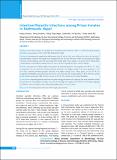Please use this identifier to cite or link to this item:
https://hdl.handle.net/20.500.14356/1417Full metadata record
| DC Field | Value | Language |
|---|---|---|
| dc.contributor.author | Shrestha, Prasha | - |
| dc.contributor.author | Shrestha, Dhiraj | - |
| dc.contributor.author | Magar, Dhiraj Thapa | - |
| dc.contributor.author | Rai, Ganesh | - |
| dc.contributor.author | Rai, Kul Raj | - |
| dc.contributor.author | Rai, Shiba Kumar | - |
| dc.date.accessioned | 2023-05-10T08:10:29Z | - |
| dc.date.available | 2023-05-10T08:10:29Z | - |
| dc.date.issued | 2019 | - |
| dc.identifier.citation | ShresthaP., ShresthaD., MagarD. T., RaiG., RaiK. R., & RaiS. K. (2019). Intestinal Parasitic Infections among Prison Inmates in Kathmandu Nepal. Journal of Nepal Health Research Council, 17(3), 382-387. https://doi.org/10.33314/jnhrc.v17i3.2015 | en_US |
| dc.identifier.issn | Print ISSN: 1727-5482; Online ISSN: 1999-6217 | - |
| dc.identifier.uri | http://103.69.126.140:8080/handle/20.500.14356/1417 | - |
| dc.description | Original Article | en_US |
| dc.description.abstract | Abstract Background: Prison inmates are at high risk of intestinal parasitic infections. Thus, we studied intestinal parasitic infections among inmates of the Central Jail, Kathmandu, Nepal. Methods: Morning stool samples from 400 inmates (M=282 and F=118), were collected in a clean, dry and wide-mouthed plastic container. The samples were transported to the research laboratory of Shi-Gan International College of Science and Technology, and were fixed using 10% formal saline. Then, samples were processed by formal ether sedimentation concentration technique and were observed microscopically by direct-smear technique. Results: Six percent (24/400) samples were positive for intestinal parasites, with a gender ratio (M:F) 1.7:1. But, co-parasitism was not observed. Intestinal parasitic infections were higher among 21-40 years age-group, 3.5% (14/262). Similarly, intestinal parasitic infections were higher among ‘Dalits’ ethnic group, 21.1% (4/19). As compared to helminths, more protozoans, 62.5% (15/24), were observed. Giardia lamblia, 41.67% (10/24), was the most common protozoans while Trichuris trichiura, 25.0% (6/24), was the most common helminths. Conclusions: Intestinal parasitic infections were lower among the inmates of Central jail, but such conditions cannot be presumed in other peripheral settings. Pure and safe drinking water supply and the effective deworming campaign can further reduce this figure at this setting and peripheral jails across the country. Keywords: Intestinal parasitic infections; IPIs; Nepal; prison inmates. | en_US |
| dc.language.iso | en | en_US |
| dc.publisher | Nepal Health Research Council | en_US |
| dc.relation.ispartofseries | July-Sep, 2019;2015 | - |
| dc.subject | Intestinal parasitic infections | en_US |
| dc.subject | IPIs | en_US |
| dc.subject | Nepal | en_US |
| dc.subject | Prison inmates | en_US |
| dc.title | Intestinal Parasitic Infections among Prison Inmates in Kathmandu Nepal | en_US |
| dc.type | Journal Article | en_US |
| local.journal.category | Original Article | - |
| Appears in Collections: | Vol. 17 No. 3 Issue 44 Jul-Sep 2019 | |
Files in This Item:
| File | Description | Size | Format | |
|---|---|---|---|---|
| 2015-Manuscript-12214-1-10-20191114.pdf | Fulltext Download | 274.53 kB | Adobe PDF |  View/Open |
Items in DSpace are protected by copyright, with all rights reserved, unless otherwise indicated.
